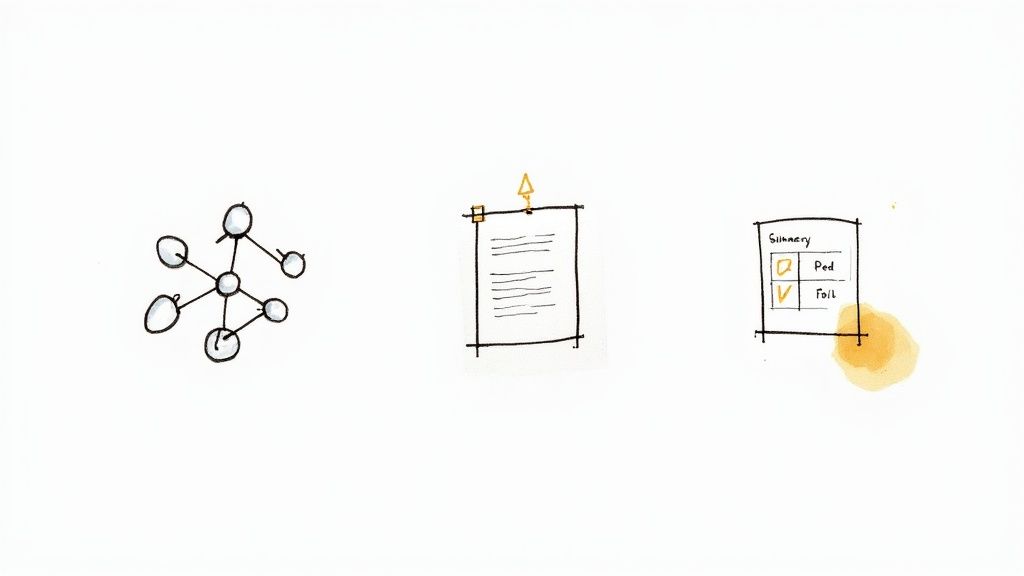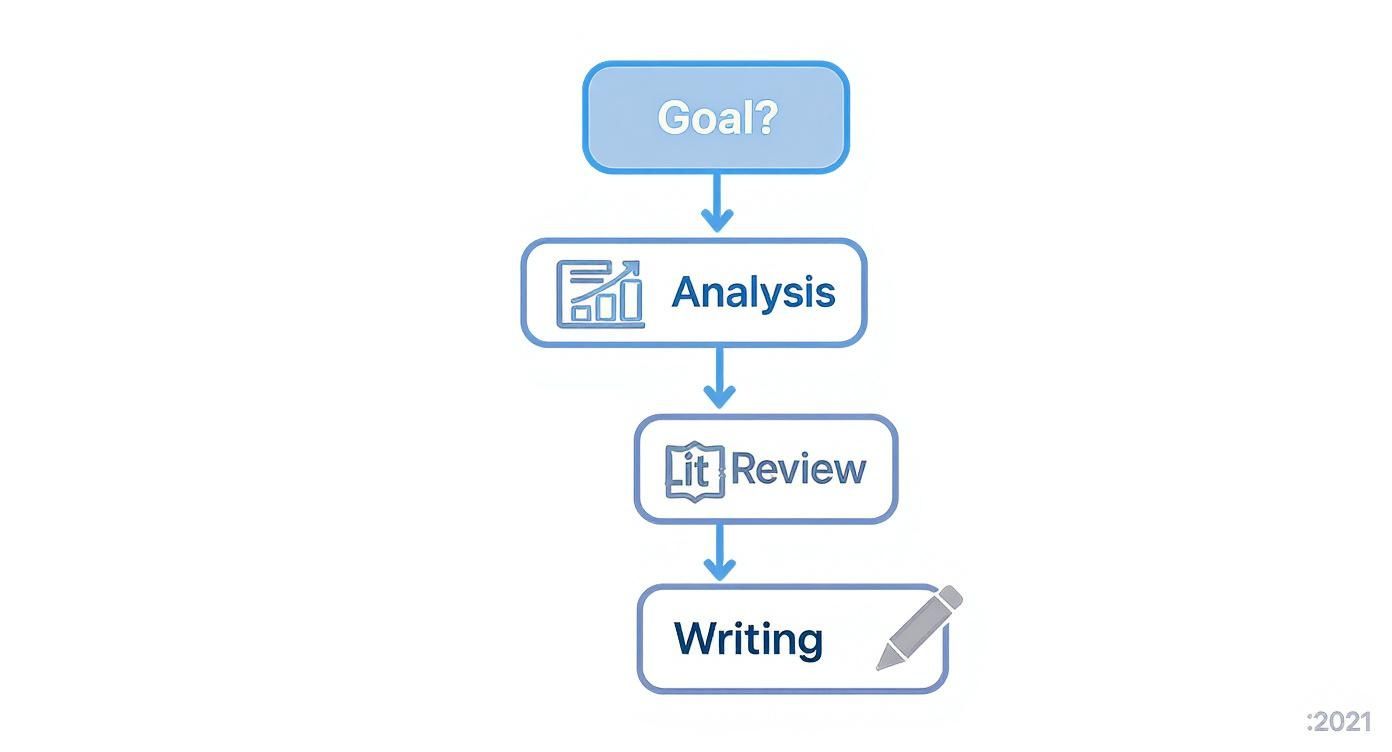Think of an AI-powered research tool as your own personal, incredibly fast research assistant. It's the kind of assistant that can devour thousands of documents in minutes, zeroing in on the exact ideas you need. Forget spending days manually digging through digital libraries; this is about using a smart system that understands the context behind your questions, not just the keywords.
What an AI Research Assistant Actually Does

Let's say you have a complex research question. The old way of doing things meant hours of formulating the perfect search query, opening an overwhelming number of browser tabs, and skimming paper after paper just to find out if they were even relevant. It was a tedious process of elimination.
An AI-powered research tool completely changes the game. It uses technologies like Natural Language Processing (NLP) to grasp the actual meaning behind your questions and the text within your source documents. It’s like having a librarian who not only points you to the right section but has already read every book and can show you the exact paragraphs you need to see.
Core Features and How They Work
At its heart, this kind of tool automates the most frustrating and time-consuming parts of research. It moves far beyond simple keyword searching into a much deeper, conceptual understanding of information. This is a big deal, and it's part of a massive shift in technology. In fact, the AI software market is expected to balloon from $122 billion in 2024 to an incredible $467 billion by 2030.
So, what does that look like in practice? These platforms usually bundle several key functions into a single, smooth workflow:
- Semantic Search: This feature finds documents based on the ideas and concepts you're exploring, not just exact word matches. You can ask a question in plain English, and the tool will pull up the most relevant passages.
- Automated Summarization: Instantly get concise summaries of long, dense articles. This lets you determine if a source is useful in seconds, not hours.
- Data Extraction: Need to pull specific details—like methodologies, data sets, or key findings—from dozens of papers at once? The tool can do that for you automatically.
Many of these capabilities overlap with those found in AI-powered writing assistants, which help you organize and articulate your findings. It's this powerful combination of discovery and writing that makes these tools so effective at turning a mountain of scattered information into structured, usable knowledge.
The difference between the old way and the new way is night and day. Let's break it down.
Traditional Research vs AI-Powered Research
| Task | Traditional Method (Manual) | AI-Powered Method (Automated) |
|---|---|---|
| Literature Search | Hours of keyword searching across multiple databases. | A single, natural language query that understands context. |
| Assessing Relevance | Skimming abstracts and full texts one by one. | Instant summaries highlighting key concepts and findings. |
| Extracting Data | Manually copying and pasting key stats or quotes. | Automatic extraction of specified data points into a table. |
| Finding Connections | Relying on memory or complex notes to link ideas. | Visualizing conceptual links and identifying related papers. |
| Citing Sources | Manually formatting citations and building a bibliography. | Automated citation generation in any required style. |
As you can see, the AI-powered approach doesn't just speed things up—it fundamentally changes how you can interact with information, freeing you up to focus on analysis and critical thinking.
What to Look For in an AI Research Tool

Not all AI research tools are created equal. When you're trying to find the right one, you have to look past the marketing hype and focus on the specific features that will actually make your life easier. These are the capabilities that can genuinely shift how you tackle a research project.
One of the most powerful features to look for is semantic search. This isn't your standard keyword search that just looks for exact word matches. Instead, it gets the meaning behind your query. You can ask a complex question just like you would to a person and get back passages that are conceptually related, even if the wording is totally different.
Imagine you're a grad student. You could ask, "How do urban green spaces affect the mental health of a community?" and the tool would dig up papers on parks, psychological well-being, and city life—making the connections for you.
Core Capabilities That Really Matter
Finding the information is just the first step. The best tools help you make sense of it all quickly, turning that digital mountain of documents into clear, usable insights without getting stuck in the weeds. A few key functions make this happen.
- Automated Literature Review: This is like having a research assistant that can scan thousands of papers to spot recurring themes, common methods, and crucial gaps in the current research. It builds the foundation for you.
- AI-Driven Summarization: Need to know what a dense, 50-page article is about? This feature pulls out the main arguments and findings, giving you a concise summary in seconds. It’s perfect for deciding if a source is worth a deeper read.
- Intelligent Data Extraction: This function can automatically pull specific details—like sample sizes, key stats, or important quotes—from dozens of sources and drop them into a neat, organized table for you.
It's not just about saving time. These features genuinely upgrade your ability to think. When you automate the grunt work, you free up mental energy for what truly matters: analyzing information, thinking critically, and developing your own original ideas.
And finally, you absolutely need seamless citation generation. A great tool doesn't just find information; it helps you track it with perfectly formatted citations. Manually creating a bibliography is a soul-crushing task that’s begging for mistakes. As you probably know, understanding the importance of a reference manager is essential for a smooth writing process, and a tool with this built right in is a massive win for your academic integrity and your sanity.
How AI Tools Actually Change Your Research Workflow
Bringing an AI-powered research tool into your process is about more than shaving off a few hours here and there. It completely redefines how you approach your work from the ground up. The most immediate win is getting back a huge chunk of your time, letting you escape the drudgery of hunting for sources and focus on what really matters: thinking, analyzing, and developing new insights.
Imagine no longer feeling like you're lost at sea, buried under a mountain of irrelevant papers. These tools help you instantly zero in on the most critical concepts and recurring themes across your entire field. They’re brilliant at spotting subtle connections and patterns that you might otherwise miss, even after days of reading. That kind of clarity can make a massive difference in the quality of your work.
From Months to Weeks: What This Looks Like in Practice
I once knew a PhD candidate who was completely overwhelmed by their literature review. The old-fashioned way of finding, reading, and piecing together hundreds of articles was looking like a three-month-long slog. By bringing in an AI tool, they slashed that time down to just three weeks.
Think about that. It wasn't just about going faster; it was about working smarter. The tool helped them:
- Pinpoint Core Themes: The AI quickly identified the most cited authors and the central arguments defining their field.
- Discover Hidden Gems: It brought up important, niche papers that their traditional keyword searches had completely overlooked.
- Structure Their Knowledge: The tool automatically sorted their notes and highlights, basically building the foundation of their review for them.
This level of efficiency is why the AI market is growing so quickly. It's expected to be valued at around $391 billion by 2025, largely because smart tools that genuinely boost our research abilities are in high demand. You can dig into more of these stats over at Exploding Topics.
When you automate the repetitive, mind-numbing parts of research, you free up the mental bandwidth to think bigger. You can start asking more interesting questions and chase down connections that used to be impossible to see.
This newfound clarity makes it much easier to juggle different projects without feeling overwhelmed. If that’s a challenge you face, our guide on how to manage multiple projects has some great strategies. At the end of the day, it's about creating a true before-and-after story for your own research potential.
Choosing the Right AI Research Assistant for You
With a flood of new tools hitting the market, trying to find the perfect fit can feel like a chore. The secret is to line up a tool’s specific strengths with what you actually need to do. After all, an AI powered research tool built for market analysis is going to be a completely different beast than one designed for sifting through academic literature.
First things first, figure out your main objective. Are you spending most of your time on literature reviews, crunching quantitative data, or trying to draft a manuscript? Just answering that one question will help you cut through the noise and narrow your options considerably. If you're just dipping your toes in and want a lay of the land, guides like these Top 12 AI Writer Free Tools can give you a decent starting point.
Next up, think about ease of use and how it will slot into your current setup. The most powerful tool in the world is worthless if you can't figure out how to use it. You want something with a clean, intuitive interface that doesn't require a manual to get started. It's also smart to check if it plays nicely with the software you already rely on, like Zotero, Notion, or your favorite cloud storage.
Aligning Features with Your Workflow
Ultimately, the best choice really boils down to how you work. A solo academic writing a book, for instance, is going to care deeply about rock-solid citation management and the ability to perform deep, nuanced searches. On the other hand, a research team working together needs features that let them easily share notes, build bibliographies as a group, and analyze sources collaboratively.
This decision tree gives you a simple way to think through the process based on what you're trying to accomplish.

As you can see, locking in your primary goal—whether it's analysis, review, or writing—is the fastest way to filter the options and land on a tool that truly makes your life easier.
This is exactly where modern solutions like Eagle Cite come in. We designed it from the ground up for academic and professional researchers. Our whole focus is on a user-friendly design that puts powerful features, like natural language search and effortless document management, right at your fingertips, no matter how tech-savvy you are.
The goal is not just to find an AI tool but to find your AI tool. It should feel like a natural extension of your thinking process, removing friction and helping you spend more time on analysis and discovery.
Integrating AI into Your Daily Research Habits
https://www.youtube.com/embed/pDOPL53tcwQ
Adopting a powerful new AI-powered research tool is one thing, but actually weaving it into your daily work is where the real magic happens. The trick is to start small. You don’t need to overhaul your entire process overnight.
Instead, pick one specific, annoying task and see how AI can help. For instance, start by uploading just a few key articles you've been meaning to read. Let the tool’s summarizer give you the gist of each one. Right away, you've replaced the tedious job of manually skimming abstracts and intros with a quick, clear overview. That's an immediate win.
This idea of starting small mirrors a much bigger trend. A recent report from Menlo Ventures points out that by 2025, while nearly two billion people will have tried AI, only about 500-600 million will be using it daily. That gap is all about integration—turning a novelty into a habit.
A Typical Research Journey with AI
Once you're comfortable, you can start mapping AI onto your entire research journey. A typical workflow might look something like this:
- Topic Exploration: Got a broad research question? Let the AI scan through databases to find those foundational papers or new themes you might otherwise miss. It's great for getting the lay of the land.
- Literature Search: Now, get more specific. Use the tool to run targeted queries, helping you pinpoint the most relevant articles and filter out all the noise.
- Summarization and Analysis: With a shortlist of papers, generate quick summaries. As you read and highlight key passages, the AI can help pull out important data points and keep your thoughts organized.
- Bibliography Creation: This is a huge time-saver. With just a click, you can generate a perfectly formatted bibliography, saving you from hours of tedious manual work and helping you avoid citation mistakes.
A common hurdle is learning to trust the AI's output. The best way to think about it is as a highly capable assistant, not a perfect, all-knowing oracle. Use its summaries to guide your reading, but always double-check the critical details against the original source.
Building that trust is what turns a tool from something you try into something you can't work without. When you see how it consistently brings relevant insights to the surface and organizes your findings, it starts to feel like a natural extension of your own thinking.
For more on this, check out our guide on how to organize research notes for some practical strategies.
Of course, here is the rewritten section with a more natural, human-written tone.
Common Questions About AI Research Tools
Jumping into any new technology brings up questions, and AI-powered research tools are no exception. It’s smart to be a little skeptical and really think through how these platforms work and where they fit into your process. Let's walk through some of the most common concerns I hear from fellow researchers.
"Can I Really Trust the AI's Accuracy?"
This is usually the first question people ask, and it's a good one. The key is understanding what the AI is actually doing. A well-built research tool isn't just making things up; it's meticulously analyzing and summarizing information from the human-written sources you give it or from established academic databases.
Think of it as a superhuman research assistant, not an author. Its job is to digest mountains of text far faster than any person could. The best way to use it is to let the AI quickly surface the most relevant papers and key arguments. But you, the researcher, should always go back to the original source to verify the details and absorb the full context.
"Is Using AI for Research Cheating or Plagiarism?"
This is another big one. When you use these tools the right way, it's not cheating at all. It's simply working smarter. An AI research assistant is designed to enhance your own critical thinking, not replace it. It's no different than using a citation manager, a statistical program, or even a powerful search engine—it just automates the drudgery.
Plagiarism means passing off someone else's work as your own. These tools actually help you avoid that by making it incredibly easy to find, track, and cite your sources. As long as you're using the AI to map out the existing literature and you remain diligent about giving credit where it's due, it's a completely legitimate academic tool.
The real goal of an AI assistant is to take over the mechanical tasks—finding papers, summarizing articles, formatting citations—so you can free up your mental energy for what really matters: analysis, insight, and creating new knowledge.
"Do I Need to Be a Tech Whiz to Use This?"
Worried you need a computer science degree to get started? Not at all. The best modern tools, and we definitely built Eagle Cite this way, are designed with incredibly intuitive interfaces that feel familiar right out of the box.
Honestly, if you can navigate a website or use a word processor, you have all the skills you need. The whole point is to make powerful technology simple to use. You can ask questions in plain English and get the help you need, letting you get back to the actual work of research instead of fighting with complicated software.
Ready to speed up your discovery process and leave the tedious work behind? Eagle Cite is the modern, AI-powered citation manager built by researchers, for researchers. Start your free 14-day trial today and see how much faster you can find the sources you need.